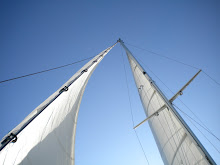What an adventure! The crew came aboard on Sunday morning about 8:30 after a night at local motels. All gear was safely stored and we carefully monitored weather and water conditions. A final check of oil and fluids and a call to the coast guard to double check conditions, which had been reported favorable on line.
We were told the Bar was actually closed to pleasure vessels under 22 feet. We waited another 30 minutes and the vessel size prohibited was reduced to 18 feet. We were at a point of departure that would have us on the Bar in slack going into a flood tide - ideal - so we decided to go.
We followed the channel carefully and kept our eyes on the horizon (fore and aft) and the radar for large ships. All went so smoothly - the water was full of swells (4 - 5 feet) so we had consistent motion, but as different as this was from our usual river waves, I didn't find it frightening. We did see breaking waves on either side of the channel, as we had read about. These were the conditions that can capsize a boat if you are swept outside of the channel.
We watched for ship traffic but did not see anything really large in the channel. We did see a yellow pilot boat deliver a pilot to a tug pulling a barge. The pilot boat drove along side the tug and the pilot simply stepped across, despite the rolling water.

Peter and Charley were starting to feel the effects of the motion - a bit of queasiness. But we were past Buoy #7, with just three buoys to go before the end of the channel, so we were almost through the first stage. At this point, the engine started to sputter and then died. Yikes! We had read that this is a frequent problem and often leads to problems as boats are swept out of the channel into dangerous waters. The usual cause is junk in the diesel which gets stirred up with the rough conditions. We were prepared - we have second fuel filter that we can switch to, we had additional filters and tools ready, and of course we are a sailboat, so we had our sails ready.
Step one was to raise a sail and get the boat under control. Unfortunately we found that one of the slides on the main sail had been put in upside down - the twist prevented the sail from rising. (Important lesson learned; always test the sails after you have removed them for any reason!) The crew was remarkably calm despite this setback.
I was concerned to note that we were now outside of the channel to the north, drifting toward Peacock Spit. Conditions were rough, so working on the foredeck was challenging, however Peter was on a tether and quickly raised the staysail, followed by the Genoa. Simon was at the helm and with the light wind was able to get the boat under control.
We were moving in the right direction, back in the channel! Charley checked the fuel filters but found that they were not clogged - instead it appeared that we had air in the fuel line, so he went below and bled the air from the line. Although we know how to do this, it was fantastic having Charley on board: as a mechanic, he was able to diagnose the problem and execute a fix much more quickly.
Everyone held their breath as we turned the key - but the engine roared to life and we cheered! The rest of the crossing was uneventful. Upon reflection, we were fortunate in that we stayed calm; we first worked to get the boat under control with sails; and we did not have issues with ship traffic.
Total time to cross was 3.5 hours from the time leaving the dock to passing the final buoy.


No comments:
Post a Comment